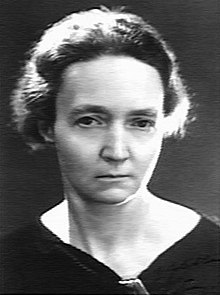Irène Joliot-Curie - Simple English Wikipedia, the free encyclopedia
Irène Joliot-Curie | |
|---|---|
 | |
| Born | Irène Curie 12 September 1897 Paris, France |
| Died | 17 March 1956 (aged 58) Paris, France |
| Cause of death | Leukaemia |
| Nationality | French |
| Alma mater | University of Paris |
| Spouse | |
| Children | |
| Relatives |
|
| Awards | Nobel Prize for Chemistry (1935) |
| Scientific career | |
| Fields | Chemistry , Physics |
| Institutions | |
| Doctoral advisor | Paul Langevin |
| Doctoral students | her children (see above) |
Irène Joliot-Curie (12 September 1897 – 17 March 1956) was a French scientist. She won the Nobel Prize for Chemistry in 1935 with her husband, Frédéric Joliot. Curie was the daughter of Pierre and Marie Curie.
Education
[change | change source]Curie started her studies at the Faculty of Science in Paris. During World War I, she served as a radiographer. Curie became Doctor of Science in 1925. She did her thesis on the alpha rays of polonium.
During World War I (1914-1918), she helped her mother using X-ray technology in military hospitals. She helped train radiological workers. Curie then graduated from the Sorbonne in Paris. She earned a degree for work on radioactivity in polonium in 1925.[1][2]
Research
[change | change source]Curie did important work on radioactivity, transmutation of elements, and nuclear physics. Curie and her husband won the 1935 Nobel Prize for Chemistry for their creation of new radioactive elements. This work was written about in their paper "Production artificielle d'éléments radioactifs. Preuve chimique de la transmutation des éléments" (1934).
In 1938, she researched the action of neutrons on the heavy elements. This was an important part of the discovery of the nuclear fission of uranium. Curie became Professor in the Faculty of Science in Paris in 1937. She became Director of the Radium Institute in 1946. After six years as a Commissioner for Atomic Energy, Curie took part in the construction of the first French atomic pile in 1948. Its construction was continued after her death by her husband.
Personal life
[change | change source]Curie was born in Paris. Marie and Pierre Curie were her parents. In 1926, Curie married Frédéric Joliot-Curie, a French physical chemist. He joined Curie’s Radium Institute in 1925. In 1934, they discovered that they that could make stable elements radioactive. Curie and Joliot had a son and a daughter. Curie was also interested in social and intellectual advancement of women. In 1936, she became the Undersecretary of State for Scientific Research.[1][2]
Curie died on March 17th, 1956.
References
[change | change source]- ↑ 1.0 1.1 "Joliot-Curie, Irene." World Book Student, World Book, 2017, www.worldbookonline.com/student/article?id=ar290381. Accessed 28 Mar. 2017
- ↑ 2.0 2.1 "Irène Joliot-Curie." Scientists: Their Lives and Works, UXL, 2006. Student Resources in Context, link.galegroup.com/apps/doc/K2641500109/SUIC?u=palo88030&xid=dacebfac. Accessed 28 Mar. 2017.
- "Irène Joliot-Curie biography". Nobelprize.org. Retrieved 25 November 2012.


 French
French Deutsch
Deutsch